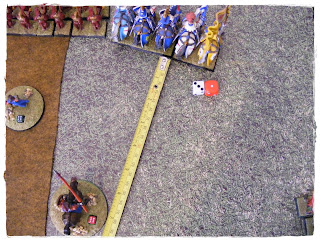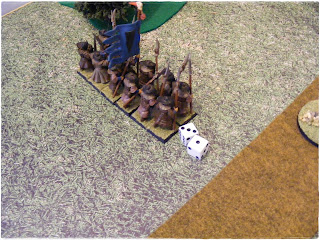Wednesday, 5 July 2017
Dragon Rampant - batrep / review / trial game
As promised, here's the (delayed, while I cleared out our box room and started to transform it into my "man cave"!!) post about these rules.
I had played through a game with a friend, but the photo's were totally rubbish (these aren't great, but loads better than the ones I had to scrap) so I christened my new table with a solo game for the blog.
Rather than it being another 'stand alone' battle, it forms part of an ongoing campaign since I needed a result from a clash between an Empire force and an Orc rearguard which remained on the wrong side of the border crossing!
Two forces were assembled to make up "24 point warbands" using the guidelines in the rule book. The only modelling I had to do was to re-base the orc chieftain, base up a couple of goblin shaman proxies, paint and base an "Earl" (command figure for the 'Men Of The West' warband) and a "wizardling" (lesser battle wizard.... sounds too much like something from Harry Potter to me, so will definitely be changing the title!!) and I ended up with 5 units for the orcs and 6 units for the humans - not huge armies, but there's no limits to the points values you might want to use for bigger (or smaller) games.
One of the simple game mechanics is that all units are either 12 or 6 "strength points" - a measure of how much damage they can take, and easily represented by the number of figures in the unit.
Additionally though, units may be represented by "reduced model units" (RMU) with a just a couple, or a single figure with some form of 'casualty tracking' (I use a mini dice in a recess on the textured base) to represent leaders or units like trolls, giants etc.
The recommended table size is 4ft x 4ft, but I played this on my 3ft square table since it was to be a quick encounter scenario in a narrow river valley.
The Empire warband are the "attackers" and so they will start the first turn :~ let battle commence......
.............and remind me to do something about that wall - it's a terrible backdrop!!
A nice bit of 'flavour' is that leaders may have "traits", which are simply diced for on a list.
The orc chieftain is Brave - not affected by fear effects, and the Earl is Strong - may re-roll one failed hit dice in any combat.
Units must be "activated" before they'll do anything, and their stats show the score needed on 2 dice if you want them to move, shoot or attack, and, here's the rub - a failed unit activation ends your turn and hands activation to the opposition. This is very similar to the 'success rolls' in Song of Blades and Heroes, and a neat way of adding a bit of uncertainty to the game - great for solo play!!
Turn 1. The knights, the red unit of spearmen and the Earl advanced to threaten the orc line, but the blue spear unit failed the move activation, ending the turn for the humans.
The orcs got the goblin wolf riders into the woods, but the archers failed their shoot activation.
Turn 2. The humans continued their advance, but the Earl failed his move activation - ending the turn before the archers could advance within range.
The orc archers opened fire - here's how it works.
They passed their "shoot activation" roll
then roll 12 hit dice because they're above half strength (if they were half strength or under. they'd roll 6 dice) and look for successes against their "shoot value"
they score 4 hits on the knights, who have a "armour value" of 3, so one knight is 'killed'. (the remaining hit is discarded - no recording or carrying forward 'loose change')
The knights must now immediately take a "courage test" because they've received casualties. Again, two dice are rolled against their "Courage value" (in their case, it's 4)
and they score 4, but it's minus 1 for each casualty (1),
plus 1 for being within 12 inches of their leader,
for a total of 4, so they've passed the courage test and will behave normally - a "zero score" fail would see them retreat and a "negative score" fail would mean a route. Any "fail" would also incur a "Battered" marker which would affect their performance until removed by passing a "rally" check.
The wolf riders decided to stay in the cover of the woods (failed their move activation), so turn 2 ended for the orcs.
Turn 3. The knights passed an "attack activation" and charged into the orc archers.
Melee is just as straight forward as shooting - the knights roll 12 dice (they're above half strength even though it's only a six figure unit) against their "attack value" while the orcs roll against their "defence value"
The Knights score 8 hits on the orcs, while the archer unit replies with 3.
The orc archers have an "armour value" of 2, so remove 4 casualties. The knights again lose one figure.
Both units immediately take "courage tests" because of the casualties (and both failed spectacularly!) routing from the field of battle.... not a lot you can do with 'snake eyes'!
The red unit of spearmen pass their "attack activation"
and charge the orc heavies to their front.
Four hits against two in the melee,
and they both pass the "courage tests", so the orcs (losing side) are pushed back 3 inches.
The blue unit decide to stay where they are..... again.......... so the orcs have the initiative.
The enraged orc chieftain charged the spears, but was pushed back (and "Battered" in the prcess)
Note to self: get some "Battered" markers sorted out!
so the goblin shaman took cover in the old toll house ruins.
Then finally the wolf riders made a move!
I gave them three random options - throw spears from the wood at the blue unit of spearmen (1-2),
attack the spearmen (3-4), attempt to 'outflank' and go for the wizardling (I hate that name!) or the Earl if possible (5-6). The dice came up with a six........
....... the wolf riders burst from the cover of the wood (and had to maintain a 3 inch distance from the enemy spearmen since they weren't "attacking" them), ending the turn.
Turn 4. Hmmmm. According to what it says in the Important Rules Conventions "There is no 'unit facing'. All models can see, move and shoot in all directions........"
So, the blue unit took and passed an "attack activation" and slammed into the mounted goblins, winning the melee 3 to 1
Both units passed the following courage tests, so the wolf riders were 'pushed back'......... and off the table edge!
The unit of archers failed their activation roll (again),
so it was over to what was left of the orc warband for their turn, which started with the chieftain attempting a courage test to rally from his "Battered" status.
Oops! Those snake eyes are contagious - that score, plus being "Battered", plus the number of casualties he'd taken, plus the number of units missing from his warband gave him a 'routed' result.....
.... and while he scarpered over the bridge, the orc heavy foot attempted an attack activation to see off the remainder of the red spear unit,
but they must have been rattled by their 'brave leader' fleeing the field! they stood firm and ended the turn.
Turn 5. The archers actually passed a move activation
and closed into range of the remaining greenskins.
Then the blue unit decided to catch their breath after the scrap with the wolf riders!
Time for the orcs to try again....... and this time they meant business!
The snarling mob crashed into the depleted ranks of spearmen,
but only narrowly won the fight despite the odds being in their favour (they rolled 12 dice compared to the spear unit 6 because they were below half strength)
Again, both sides failed the courage test after taking casualties, and the orc unit was routed.
The goblin shaman was the only remaining unit, so when he passed the move activation,
he decided (1-3 do summat daft, 4-6 retreat) to retreat over the bridge,
ending the turn and the game!
Only the second time I've played the rules, and I have to say, I really enjoyed them!
Not sure how they'll be with bigger forces, so I might still use good old 3rd edition Warhammer, but I'll give 'em a go.
Excellent fun, and I'm looking forward to spending some more time in my new "gaming space"!
EDIT:- I forgot to mention, the rules as printed specify that ALL units must maintain a 3 inch distance between them (friend and foe alike), unless one unit is "attacking" another.
There's been plenty of debate about this on the interweb, and generally agreed that the rule should be dropped regarding 'friendly forces' - which I've done in my own games (just in case anyone reading the above AAR takes exception to my battle lines)
Subscribe to:
Post Comments (Atom)




































Nice AAR dude. I quite fancy this ruleset
ReplyDeleteThanks Andy, the write-up feels a bit messy to me, a bit of a collision between 'review' and 'AAR', but I was keen to illustrate the basic mechanics.
DeleteDefinitely an easy game to get into and it does exactly what it says on the tin :-)
I had never heard of Dragon Rampart before, so this was all new to me. I doubt if it's for me but that didn't stop me from enjoying your batrep.
ReplyDeleteMuch appreciated Bryan.
Delete"Fantasy battles" are a lot lower on my own list of gaming priorities at the moment, but the DR rules are ideal for resolving the conflicts going on behind my ongoing D&D campaign.